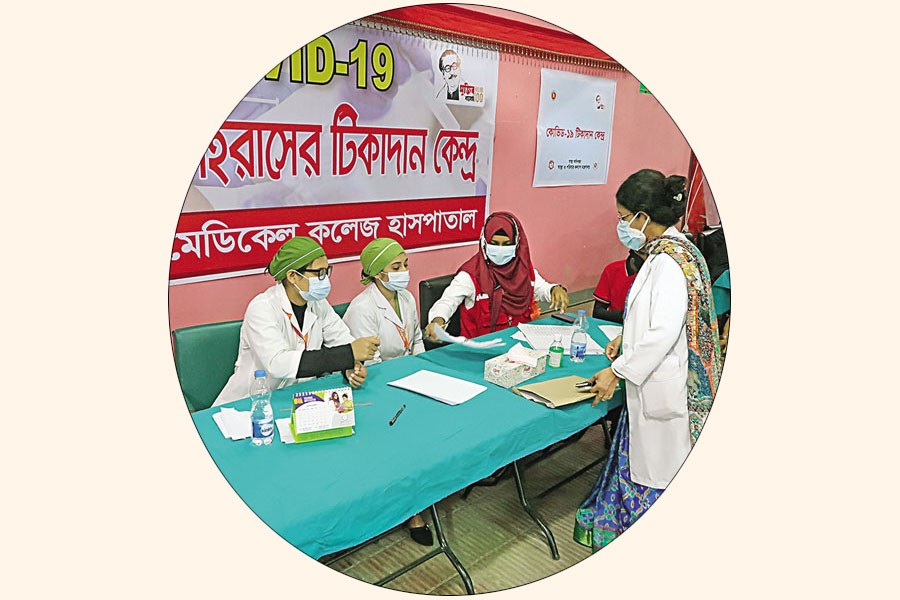
Corona casts shadows on Bangladesh's LDC graduation progress
Monzur Hossain | Wednesday, 24 November 2021

 The Covid-19 pandemic has shaken the entire world with waves of infections and deaths and disruptions to usual course of life and activity, leaving poorer countries' development efforts in grave uncertainty. The pandemic, which started off from Wuhan, China, in early January 2020, has forced Bangladesh to defer its LDC graduation voluntarily by two years in the context of uncertainties surrounding economic recovery. If everything goes well, Bangladesh is now set to graduate in 2026 -- the initial cut-off time was 2024. Bangladesh met all the criteria for graduation from LDC status in the UN-CDP's first and second Triennial Review (TR) held in March 2018 and February 2020 respectively, based on economic progress until 2019 or before the pandemic. The country had been faring well, until the start of the pandemic in March 2020, which made Bangladesh's position in terms of all the graduation criteria very promising.
The Covid-19 pandemic has shaken the entire world with waves of infections and deaths and disruptions to usual course of life and activity, leaving poorer countries' development efforts in grave uncertainty. The pandemic, which started off from Wuhan, China, in early January 2020, has forced Bangladesh to defer its LDC graduation voluntarily by two years in the context of uncertainties surrounding economic recovery. If everything goes well, Bangladesh is now set to graduate in 2026 -- the initial cut-off time was 2024. Bangladesh met all the criteria for graduation from LDC status in the UN-CDP's first and second Triennial Review (TR) held in March 2018 and February 2020 respectively, based on economic progress until 2019 or before the pandemic. The country had been faring well, until the start of the pandemic in March 2020, which made Bangladesh's position in terms of all the graduation criteria very promising.
Graduation from LDC status has great significance at the advent of country's 50 years of independence, not only because of its enduring journey from the scratch in 1971 but it also reflects country's promising journey by proving wrong all pessimists' predictions about Bangladesh being a basket case. The achievement is likely to enhance the joy and satisfaction for the people of the country. However, the global heath emergency has halted fast-track economic achievements. Covid-19 management by the government up till now may not be rated bad rather, to some extent, it is better than many other comparators, particularly in managing vaccines for a large
Covid-19 management by the government up till now may not be rated bad rather, to some extent, it is better than many other comparators, particularly in managing vaccines for a large  proportion of the population and keeping the infection rate at a reasonable level with low rate of mortality. Economic management in the context of Covid is not that excellent though the government declared various stimulus packages of worth over one lakh crore taka (about 3.5 per cent of GDP), though most are credit-based supports with subsidized interest rates, for various affected quarters, including large and MSMEs, agriculture as well as fiscal transfer for the poor. The implementation of support packages is not fully on-target because of weaknesses in delivery mechanism.
proportion of the population and keeping the infection rate at a reasonable level with low rate of mortality. Economic management in the context of Covid is not that excellent though the government declared various stimulus packages of worth over one lakh crore taka (about 3.5 per cent of GDP), though most are credit-based supports with subsidized interest rates, for various affected quarters, including large and MSMEs, agriculture as well as fiscal transfer for the poor. The implementation of support packages is not fully on-target because of weaknesses in delivery mechanism.
The government, however, has been able to make a balance between the 'life and livelihood' dichotomy with some luck, as the decisive decisions of the government to reopen the economy even with high infection rates has not become counterproductive in the end. The decision of allowing export-oriented RMG sector to continue its operations even during lockdowns was brave and wise as the sector has revived without any catastrophic consequences. Such decisions not only help keep the momentum of the sector but also saved jobs of millions of women workers. During the Covid-19 pandemic, international remittances were on a rising trend, thanks to inactive illegal hundi service, which was to some extent a blessing in disguise.
However, with sluggish domestic demand, many other sectors have yet to see full operation. Since the infection and death rates are now stable, hovering below 2.0 per cent, people are now getting involved at a higher rate in various economic activities. A note of caution is that overheated economic activity in the recovery phase might invite some adverse consequences to the economy, such as high inflation and exchange-rate depreciation, high rate of non-performing loan, and so on. A better economic management is therefore warranted, and any lacklustre economic decisions might have long-term negative consequences on the economy and country's graduation process.
Since the Covid-19 pandemic has given rise to uncertainties, there is no room for complacency. Bangladesh's graduation is largely dependent on how quickly the Covid crisis is contained and the economy rebounds to normal. A successful vaccine rollout can help the economy revert to normalcy. So far, 25 per cent of country's population got one dose of vaccine and the government is working to bring about 50 per cent under vaccine rollout by early 2022. Given the situation, it is also important for the government to decide and negotiate with development partners to continue international support measures.
Any successful recovery depends on how quickly a country could assess the situation and take proper decisions. Even though Bangladesh passed second TR in 2021, how long the covid impact would last on the economy is a cause of concern. Given that the impressive and high sustained growth over the last decade was supported by higher investment (hovering around 32 per cent), active participation of small, medium, and large enterprises, fiscal sustainability, robust export and remittance growth, among others, how much these channels have been affected warrants further analysis and assessment. Without proper assessment, it would be difficult to embark on smooth transition to graduation. Adverse economic consequences might have lasting consequences on country's success in social sectors, too, such as in life expectancy, child and maternal mortality, adult literacy, female-male ratio in secondary level and so on. To this end, I think that the following questions are exceedingly important to be answered for better and quick economic recovery.
• What are the major channels through which the Covid-affect Bangladesh economy, and in particular what are the likely impact of Covid-19 on the four economic sectors- real, fiscal, monetary and external economy? How the Graduation Trajectory may be impacted in various likely scenarios?
• To what extent Covid-19 impaired or may impair country's productive capacity and structural transformation?
• What are the priorities of the government in terms of moderate, severe and very severe scenarios of Covid-crisis in order for recovery of the economy?
• What are the policy responses of the government in order to foster economic recovery and smooth graduation in 2026?
To understand the economic impact of covid crisis, in the first place, it is important to provide an analysis of the gravity of pandemic and associated support measures on various sectors of the economy. Furthermore, it is important to draw scenarios of covid crisis in our trade partners and possible impact on our trade. This analysis will help us assess where we stand and what would be the likely response in the short to medium term.
The World Trade Organisation or WHO recently predicted that the covid-19 pandemic could continue two more years because of vaccine inequality as many poor countries have not yet received vaccine more than 5.0 per cent of population. Therefore, the economic response of covid crisis may be outlined in three scenarios: SEVERE, MILD to MODERATE and NO-Covid. The severe situation emerges when the government imposes countrywide lockdown and 'mild to moderate' situation represents partial opening up.
It is important to respond properly by providing stimulus and supports to economic agents during lockdown to manage the crisis. On the other hand, during mild to moderate situation, it is important to respond to crisis and attempt recovery by learning from the crisis. Finally, in a non-covid situation, which is contingent on full vaccination, the economy will thrive to a quick V-or U-shape recovery for which appropriate measures would be required. These interactive scenarios and related responses are presented in a diagram below.
With the above-mentioned phases of economic management under Covid situation, such as respond, recover and thrive, the graduation process involves some uncertainty and therefore the following factors need to be addressed carefully.
THE GRAVITY AND EXTENT OF COVID-19 PANDEMIC: The whole process depends on how quickly we can flatten the pandemic curve and how quickly we can come out of the crisis. Bangladesh government had imposed a lockdown in two periods in 2020 and 2021 respectively and then reopened the economy considering the livelihood concern of the people even when the infection rates were high. In case of high infections again, the government might have to go for lockdown once more. It seems that the situation will not return to normal until complete vaccine rollout or hard immunity realized. Therefore, quick access to vaccine for all the LDCs needs to be ensured for which some coordinated efforts from LDCs as well as UN system are desirable.
MAINTAINING LIVELIHOODS AND RECOVERY OF THE ECONOMY: During the lockdown, the government initiated a package of monetary-and food-support stimulus of around Tk 100,000 crore to support the poor, farmers and agriculture sector, MSMEs and export-oriented readymade garment industry. Though the delivery/targeting process has some challenges in terms of leakages and pilferage, a quick and efficient delivery of stimulus might facilitate the recovery of the economy, at least it might control further damage.
The stimulus package needs to be redesigned in terms of its coverage and objectives. A database of the poor and MSMEs has been felt a dire necessity in implementing stimulus and social-safety measures, and therefore, it's high time to start the process of preparing the database. Since the next census is knocking at the door, a few questions may be added there to identify the poor, which will help the government provide them identification. On the other hand, BBS's economic census 2013 database may be used to create a database of MSMEs, which will facilitate the stimulus credit to this sector.
EXPORTS AND REMITTANCES: Though Bangladesh is the second-largest exporter of readymade garments in the world market, due to covid-19 pandemic, its export sector was one of the worst-hit due to decrease in demand in importing countries. The good news is that western markets are reopening amid high rate of vaccine rollout in those countries and therefore there is a positive outlook for quick recovery of RMG exports of Bangladesh in the near future.
Though remittances were buoyant last year (2020), it now started declining and such trend might continue until the host countries recover fully. Nonetheless, there is no alternative to diversification of the export basket for long-term sustainability concerns.
GDP GROWTH AND GNI PROJECTIONS: Given a lacklustre lockdown and low infection rates, Bangladesh economy grew far better than many other comparators. Though Bangladesh expects about 6-7 per cent GDP growth in 2021-2022, the WB and the IMF forecast a much lower GDP growth. If the economy revives in 2021 with availability of vaccines, it is possible to achieve a higher growth in 2022. With a low-to-moderate GDP growth, per- capita income is expected to increase given that the economy will not contract further. If the government properly addresses the income vulnerability of the poor (including the new poor) by expanding social- safety-net programmes, it is possible for Bangladesh to maintain the threshold level of GNI set in the graduation criteria.
PUBLIC HEALTH AND EDUCATION: The Covid-19 crisis has brought an opportunity for the government to increase public health expenditures with an aim to rejuvenate public-health system. Given adequate hospital facilities for the covid patients, the government has been apparently increasing its capacity to improve public-health facilities. At the same time, lockdown and fear from virus affect education system greatly. More online lecturing system was required, but given the digital divide and weaknesses of capacity in the public- sector educational institutions, online education for all could not be materialized.
Further investment in public health and education is necessary, and if it is invested ensuring good governance and proper planning, it is possible to overcome the covid-induced losses.
DEBT FINANCE AND SOURCES OF FINANCE: Bangladesh's public debt-to-GDP ratio is one of the lowest in South Asia, and it has been maintaining a reasonable budget deficit at around 3.1 per cent of the GDP over time (on average). The debt-sustainability analysis of WB and IMF suggest a solid debt-sustainability position for a longer period, and given the current situation and country's resilience in debt management, sustainability will remain intact.
Therefore, to manage the covid crisis, there is scope for the government to increase public expenditures by exploring alternative sources of finance. More reforms in tax system, SOEs and subsidy management might give a leeway to finance the deficit.
Given the above analysis, there are scopes for Bangladesh to recover the covid-induced crisis more quickly. In this article, I have emphasized two issues: a proper analysis of covid-induced economic loses and a proper economic recovery plan. As already hinted, recovery phase may entail certain risks that might be taken into account to maintain a sustainable growth path. A high-level economic-management committee involving experts may be an option.
However, there is no room for complacency in the recovery phase. Only then the graduation process is expected to be smooth and viable.
Dr Monzur Hossain is a research director at Bangladesh Institute of Development Studies (BIDS). The views expressed here are the author's own.
monzur@bids.org.bd